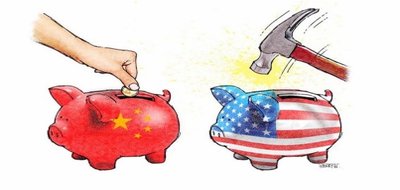Chinese economy will overtake America’s – thanks to Chinese values of thrift and hard work
SCMP (2015.01.05, Comment – Insight & Opinon)
The latest data from the International Monetary Fund shows that, in terms of purchasing power parity, China’s gross domestic product in 2014 is estimated to have surpassed that of the US. That has made for uncomfortable reading for those long aware of China’s rise, but who have prided themselves on America’s continued domination.
Of course, in terms of nominal GDP, in which exchange rates are taken into account, American output is still higher than China’s. And America’s per capita GDP remains significantly higher. But, at the rate of China’s present economic growth, the output gap can easily be closed within a decade.
With regard to per capita GDP, China will not outperform the US in the foreseeable future. However, it is important to understand that the competition for global leadership is actually determined by the country’s overall economic strength. While many European countries (such as Switzerland and Norway) have higher production per capita than America, their small populations and scale allow for very limited influence in the global arena.
It is no wonder therefore that one commentator, for example, sees China’s rise as a historical moment, describing it a “geopolitical earthquake with a high reading on the Richter scale”. He further cited the fates of the British, French and Spanish empires as a result of their declining economies, implying that the US is on the same path.
I hesitate to be too enthusiastic about the rise of China’s economy and its newfound international status based solely on these numbers. After all, the US still holds an absolute advantage when it comes to attracting internationally acclaimed talent across various sectors from around the world. It has the highest number of Nobel laureates in innovation and technology, and China’s closed-door plagiarism can only come so close.
So how can the Chinese, still relying heavily on labour-intensive, low-technology manufacturing exports, catch up?
The US still leads when it comes to the quality of the top echelon of its society. The problem, however, is that the majority contribute little to the economy compared with their overseas counterparts. China’s advantage lies in its mainstream – its low-income and middle-class public, who boast superior diligence and more resilient attitudes in general. This provides a sound platform for China’s rapid rise.
Furthermore, America’s mainstream financial media often stresses the importance of consumption for economic growth. The belief is that if citizens refuse to spend, the government will need to do so on the people’s behalf.
This flimsy theory goes further, claiming that if growth is far from the target rate, the central bank will have to intervene, printing money to stimulate consumption or using negative interest rates to punish savers, forcing them to spend. For decades after the second world war, only the top 10 per cent who really understood the rules of the game invested their savings in multinationals’ stocks, real estate, jewellery, antiques and artwork.
The majority have heeded the government inducement to consume more and save little. The main problem is that when consumption becomes a habit, most people lose the ability to save, and the government is forcing itself to bear future responsibilities for these short-term-thinking and welfare-reliant individuals.
According to census data, in 2011, 108 million low-income Americans received welfare, exceeding the 101 million full-time employed individuals in the country. Together with non-means-tested welfare programmes, including social security and veterans’ living expenses, the total number of people receiving benefits amounted to 150 million – nearly half the US population. The question therefore must be: despite boasting top innovators that contribute strongly to society, with such a large scale of non-saving and non-productive citizens who are a huge burden on the state, how can the US not fall behind eventually?
Observing China, it’s easy to criticise the authoritarian ruling party. However, there is one thing the Communist Party has yet to successfully change: the industrious working temperament and high-saving habits of ordinary Chinese, particularly the older generation.
Today, when the younger generation is praised for saving 20 to 30 per cent, many Chinese still choose to spend only 30 per cent of their income, piling the rest into savings and investments. Because of such high wealth accumulation, Chinese will be able to continue the construction and earning of foreign exchange to make up for any mistakes in government policies.
The recent heavy speculation in Shanghai stocks was possible thanks to retail investors’ big savings, and is evidence that private capital is abundant.
If the share prices of debt-ridden state-owned banks are buoyant, there is a strong incentive for them to raise funds through rights issues or private placements to solve their balance sheet problems, and it may be possible to alleviate the effects of the 2008-09 stimulus programmes, which created production overcapacity in many industries. At the same time, the Communist Party can maintain firm control on the banks.
Looking at the ups and downs of the Chinese and US economies again proves the validity of the Austrian business cycle theory that savings are the foundation of prosperity, and Keynesian stimulus spending only worsens recessions.
Whether the Chinese economy can truly surpass America’s will depend on Chinese people’s ability to value the virtue of saving and counter the “spend your way to prosperity” propaganda from the West that will eventually shoot itself in the foot.
Peter Wong is executive director of the Lion Rock Institute

